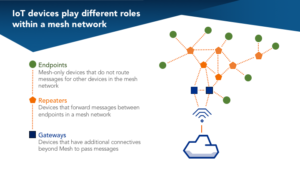Did you know that the internet itself is a mesh? Unlike traditional networks governed by internet service providers, mesh networks do not have a single point of failure. As long as you have a single wired router within the coverage range of other nodes, the network will continue to operate and will not go offline until all of the wired nodes are deactivated. The internet as a mesh network raises many controversial issues as well, such as the stagnation of nationwide population surveillance. How can that possibly happen?
Well, one of the main ideas behind a mesh network is the decentralization of information, therefore, as discussed previously, there is no singular point of access that would allow government agencies to spy on their citizens (as with traditional internet service providers). Instead, information is spread through dozens or even hundreds of nodes making it difficult to monitor, censor, or even manipulate your information. This is only one example of the capabilities, use cases, and features of a Mesh Network.
Therefore, in this blog post we will talk about what a mesh network actually is, followed by why they are becoming more popular today. We will then move on to discuss the advantages of using a mesh network and its various application areas, and finally, we will provide an example of a technology which has a mesh topology, which is Radiocrafts’ own RIIM™, Radiocrafts Industrial IP Mesh.
What is a Mesh Network?
Have you ever heard of the saying “Don’t put all your eggs into one basket?” In case you have not, it simply means, do not concentrate all your efforts into one area as you could lose everything and have no other possibilities if things go wrong. Well, this is, in a broad sense, what a mesh network entails. In a less analogical and more technical viewpoint, a mesh network is an infrastructure of nodes that are wirelessly connected to each other. These nodes piggy back off each other to extend a radio signal route, relay, and proxy traffic to/from clients. Each node spreads the radio signal a little further than the last minimizing the possibility of dead zones.
The components of a Mesh Network include:
· Gateway – Devices that allow you to pass messages between networks. These devices provide a backhaul to the internet from the local mesh network.
· Repeater – Devices that forward messages between end devices in a mesh network.
· End Point – End devices are mesh-only devices that do not route messages for other devices in the network.
Mesh networks have been around for a while now, but have only gained popularity as of recent times. Why? Because mesh networks were wired which made it expensive, and complex to set up on a large scale. Additionally, building beyond a single-point connection requires high-cost hardware solutions. As the IoT matures and grows at an incredible rate, experts have come up with new and innovative ideas to improve the industry, and now, we are able to setup wireless mesh networks. Wireless mesh networks eliminate the cost of installing wires in complicated areas, they are extremely adaptable and expandable too as wireless mesh nodes can simply be removed or added to the network, and more. Let us touch base with more benefits in a mesh network, shall we?
What are the benefits of a mesh network?
The main benefits of a mesh network include:
· Self-configuring – In the future, one major issue being examined is a technologies ability to cope with large node counts. Imagine having to manually configure hundreds of thousands of nodes in a network, this is either quite costly or simply impossible to do. In a mesh network, the nodes configure themselves.
· Self-healing – What we mean by self-healing here is that the network is more resilient and capable of recovering from a failure on its own. A mesh network is in a constant discovery process. It’s nodes automatically inform each other of path changes, for instance, if a node failure occurs causing the data packet to have to find a new path to reach its destination. In this case, we need to perform rerouting.
· Great coverage –In a mesh network, you can easily change the size of the network, for example, you can simply add and remove nodes from the network at your will. Additionally, devices in a mesh network can retransmit signals further, they have an ability to connect thousands of sensors over a wide area. Since mesh networks are self-optimizing as well, the network will find the most optimal way to send data through to/from the new devices so that efficiency is not given up.
So now that we have gone through what a mesh network is and what its benefits are, what are some applications which are best suited for a mesh network?
Mesh Network Ideal Applications
Ideal applications include:
· Smart Cities – Wireless mesh networking is great for extending radio signals through parking garages, schools, university grounds, business parks, and more. Parking garages that utilize space availability checkers for instance, benefit greatly from mesh networks as they can extend the signal throughout the entire space, allowing them to be able to communicate when a spot has been taken by a driver or become available.
· Smart Home – Wireless mesh networks can help you track and manage temperatures across your house. Setup one powered gateway and use temperature sensors and mesh-enabled nodes in each room to capture live data and adjust settings automatically.
· Agriculture – Wireless mesh networking is also great for tracking sun exposure and water levels across your crops. You can scale at a low cost with mesh-enabled nodes across your entire farm land.
An example of an easy-to-use and efficient mesh network is Radiocrafts’ own RIIM™, Radiocrafts’ Industrial IP Mesh.
RIIM™, Radiocrafts’ Industrial IP Mesh
RIIM™ (Radiocrafts Industrial IP Mesh) is an embedded RF system designed to be an all-inclusive, easy to use mesh, with direct IP addressing. The RF protocol is the IEEE802.15.4 g/e standard. RIIM™ includes an Intelligent C-programmable I/O (ICI), which makes it possible to directly interface to any sensor or actuator, and, it supports Mist Computing. RIIM™ does not require any license or subscription fee.
RIIM has several benefits which include:
· Everything is included in the module – The complete IP mesh with all features are included in the module. It is ready to go when you get the module, you just have to add the PAN ID, the sensor interface of your choice, battery power, and antennas, and voila! You are done!
· Fast and Easy Design – You can write your application for the RIIM™ modules using Radiocrafts’ (ICI) Intelligent C-Programmable I/O. ICI is a tool which allows our customers to create complex applications managing and interfacing sensors and actuators in less than 100 lines of C-code, removing the need for embedded firmware designs. ICI allows designers with no understanding of a real time operating system — or experience in RF — to create an intelligent network node. ICI also provides resources for mist computing.
· Interface to any sensor/actuator – The ICI interface provides a universal interface to most sensors/controllers. This interface together with the over-the-air capabilities of RIIM™, allows RIIM™ to interface directly to most current and future sensors/controllers.
· Great range and coverage – RIIM™ has great range and coverage. It can reach a range of 700m in an urban environment and can hop 29 times. This means that RIIM™ can have a Manhattan styled network which covers 40km x 40km.
· Over-the-air updates – The ICI application code can be modified using over-the-air updates when the network is already fully deployed and fully operational, which makes the solution future proof, as new sensors can be added, removed, or changed when the need arises. The user can update the user defined ICI firmware.
Creating your own application has never been so easy with ICI! Read more about it here.
To learn more about RIIM™, click here.
What to take away from this?
What you should take away from this blog post is that mesh networks are slowly becoming popular now that we are able to have wireless mesh networks. Therefore, we need to understand the structure of a mesh network, the benefits, the important applications, and more so that we can make an educated and informed business decision, for example, if we would like to use RIIM™ on our IoT project.
So, what is your opinion on mesh networks? What existing mesh networks out there do you think can make an impact in the industry? Do you disagree with any of the statements we have made? Use the comment section below to start a discussion, ask questions, or just to give feedback and say hi. Radiocrafts or another blog reader will answer!






